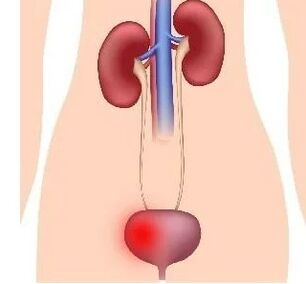Bladder- This is a pathology characterized by the development of an inflammatory process that affects the wall of the bladder as a result of the consequences of bacterial microorganisms.
Statistical cystitis- One of the most common urological abnormalities. Women are much more prone to the occurrence of this inflammation because of their morphophysiological properties.
Bacterial agents entering the bladder cavity are possible in three ways:
- The increasing way- through the urethra (urethra). In this version of the penetration of microorganisms, the main role of female urinary tract anatomical and morphological properties is a short and wide urethra, closely alienated by the anus and vagina.
- Down road- From the kidneys. This option develops for kidney inflammation, such as chronic pyelonephritis.
- Hematogenic- The rarest option is determined when cystitis occurs immediately after infectious diseases, or when the female body is observed in another source of purulent infection. In the bladder, a bacterial microflora is also probable that anatomical anastomoses (connections) appear between the lymphatic systems of the genitals and the bladders, with inflammatory changes above.
The most common pathogen of the inflammatory process of the bladder is E. coli (4 out of 5 cases, resulting in the aforementioned anatomical and morphological characteristics and the presence of this microflora in the intestine).
Less frequently, cystitis is associated with staphylococcus, streptococcus and enterococcus microorganisms. Gramm -negative sticks cause inflammation of the bladder due to instrumental and surgical interventions.
Recently, the occurrence of cystitis related to fungal microorganisms, the simplest and viruses have increased.
Only the introduction of infectious microorganisms is not sufficient for the development of a complete inflammatory reaction of the bladder, as the body contains resistance mechanisms due to pathogenic vegetation.
Cystitis development factors
Thus, in addition to the etiological factor, factors such as:
- haemodynamic function disorder(circulation) of the pelvic organs and especially the bladder;
- An abnormality of bladder emptying function(stagnation of urine);
- Inhibition of various immune connections of the body(Lack of vitamins, low temperature exposure, stress, increased fatigue, etc. );
- The passionate effects of biochemical agentsand the replacement of products released in the urine to the structure of the bladder wall;
- Exposure to radiological rays;
- The filled with hygieneexternal genitals and random sexual relationship;
- The pathology of the stomach -gel tractin which the microflora accumulates and increases its activity that later enters the urinary tract;
- Regular shifts of hormonal metabolismWhich leads to the lack of a urethra sound and creates the best conditions for infection.

The first symptomatic manifestation of cystitis in women
The clinic of acute cystitis in a woman is characterized by a sudden start and a pronounced symptom complexWith:
- The appearance of frequent urination (polliuria)which is characterized by at least once every 60 minutes and is characterized by a small amount of release urine; With frequent mandatory urgency, patients are unable to control and maintain urine;
- Dysuria (a violation of urination)accompanied by pain in the hypogastric region (lower abdomen). In the bladder wall, these symptoms progress as the degree of inflammatory process: the more often the desire for urination and the more intense pain;
- Itching in the urinary tractIt arises during urination. Develops due to the exposure of mucosal products of the metabolism of microorganisms, which caused inflammation of the bladder;
- The appearance of blood dropsAt the end of the Urine Act;
- The cloudy appearance of urine, many blood cells (leukocytes and red blood cells), bacterial microflora due to cells of the surface epithelium of the inner wall of the bladder;
- Such patients are not characterized by a change in general condition.Patient temperature indicators are characterized by normal or slightly increased (low gradu) numbers. Scientists associate this with the fact that the bladder mucosa does not virtually suckle in the metabolic products of microorganisms, which, when entered the blood, generally leads to intoxication of the body and the development of characteristic symptoms of inflammation.
Sudden symptoms and a woman's body's previous hypothermia relationship. Sometimes the phenomena of acute inflammation can be observed for 2-3 days and disappear independently without the use of therapy. 
However, this process is most often over 6 days, sometimes up to 15 days. The subsequent presence of the disease and the appointment of treatment is also required, and requires the appointment of further test methods to identify parallel pathologies of the body.
Characterization of pain in cystitis in women
In patients with acute cystitis, the different severity of the pain syndrome is observed:
- During the inflammatory process, patients feel insignificant severity or pain in the lower abdomen.Sensitive pains at the end of the Urine Act accompany moderate Pollakiuria. By further development of the inflammatory process, the intensity of the pain increases. After that, this syndrome accompanies the beginning or whole of urination. The pain is not related to the act and is almost constant and accompanied by very painful palpation of the bladder.
- In a situation where heavy cystitis developed, Patients should be urinated at least 2-3 times per hour, accompanied by significant pain syndrome and urethral emissions at the end of the law. Pain significantly worsens the quality of the patient's life as they do not disappear all day.
The presence of blood cells and blood in urine in cystitis (hematuria syndrome)
When the bladder walls develop an inflammatory process, it affects the tissue areas near the urethral confluence and the urethra exit. The tissue relaxes and bleeds.
The appearance of micro- and macrohematuria (or blood) in the urine, which is often observed in the urination law (terminal hematuria).
One of the most severe forms of acute cystitis is bleeding. This type of inflammation occurs by significantly penetrating red blood cells (red blood cells) from the bloodstream of the nourishing arteries into the bladder cavity.
This option is possible when increased permeability of blood vessels (anemia, vitamin deficiency, blood system disorders) or damage to the above walls with bacterial cells (usually Streptococcus flora). The red blood cells, which fall into the spotted urine of the bubble cavity in the bloodstone.
When hematuria occurs, the doctor is required to make differential diagnosis between acute cystitis and complex acute bleeding cystitis. To do this, additional test methods are required, the type of lesion is clarified and the most appropriate schema is chosen.
Characteristics of acute and chronic cystitis in women
Sharp cystitis
By summing the above information, it is possible to distinguish between the sharp development of the disease and the presence of a certain symptomatic complex in acute cystitis:
- Frequent urination in small portions,
- The pain of pain of various nature,
- itching that involves the act of urinating,
- The appearance of blood drops at the end of the plot,
- The woman's unchanged general condition.
With a real and timely diagnosis, the pathological condition heals within 6-10 days. In the absence of developments after the 15th day of the disease, it is worth thinking about chronicle of inflammatory changes. 
In addition to bleeding, there are two forms of a complex course for acute cystitis:
- Fun.The gangrenous form is rarely found and occurs due to the blood supply or innervation of the bladder. From a clinical point of view, such cystitis manifests itself with difficulty, pain, high body temperature, pain in the sacred region. The process is extremely dangerous to the development of awesome complications such as peritonitis and requires rapidly taking the measures needed for treatment.
- Phlegmonous.The phlegmon is accompanied by significant intoxication of the body, high body temperature, and a small amount of urine (oliguria). Urine, with such complex current, putre -active scent, muddy character, fibrin formation flakes, blood mixtures.
The duration of the pathology process increases significantly when the complex forms are developed.
There is another form of cystitis - interstitial.This is characterized by inflammation of all urinary bubbles. The clinic is dominated by sharply rapid urination, reaching 180 times a day, active complaints in the hypogastric region when filling the bladder and filling in the regression on the urine law. The capacity of the bubble is significantly reduced, resulting in the above symptoms.
Chronic cystitis
Chronic cystitis, as opposed to acute, is rarely a primary pathology, and in most cases it is a secondary complication of existing pathologies of the bladder, kidneys and urethra.
In this fact, careful examination of the presence of the above pathological changes and the exclusion or strengthening of microorganisms - tuberculosis - the invasion of Trichomonas.
From a clinical point of view, chronic cystitis either shows moderate differences in clinical analysis of complaints and urine, or in the form of repetitive pathology, with aggravation periods (similar to the clinic of acute cystitis) and complete regression (lack of lack of mulitics of the pathological process).
Thus, the objective manifestations of chronic cystitis correspond to the acute process. They are connected to the common protective properties of the body, a bacterial etiology that caused an infectious procedure and the severity of the inflammation. Pain, frequent urination, itching, presence of blood and urine clouding are less pronounced in the orbit and corresponds to the acute process with the recurring course of chronic cystitis.
Due to the lesion of the inflammatory reaction of the mucous membrane, the increase in edema of all layers of the urinary wall and intracacear pressure has created all circumstances for the formation of the bladder memorial reflux, ie the bladder from the bladder from the bladder from the bladder (connecting the kidneys and bubbles).
The doctor-urologist is involved in checking the diagnosis of cystitis and therapy.
To correct diagnosis of inflammatory pathology, patients' complaints and history (which precedes the pathology) are clearly recorded.
Clinical manifestations are quite specific and can immediately show the presence of this disease, however, differential diagnosis of all types of cystitis and other bladder pathologies and abdominal diseases should be performed.
Low temperatures, drugs taken, and data on the stress and effects of other injuries localized in the pelvic organs and the genitourinarinal system will be useful.
After clarification of complaints and a history, clinical (general) urinary analysis can help control the diagnosis - increased levels of white and red blood cells (leukocytes and red blood cells).
To identify the type of bacterium -microorganism, which causes an inflammatory process, the urine leads to a special nutrient feed, which can be used in the future to select the most effective antibacterial drug.
Before the urine fence required for bacteriological examination, the area of the external genitals should be treated qualitatively with an antiseptic solution. Treatment of cystoscopy is contraindicated in the presence of an acute inflammatory reaction.
Cystoscopy helps to diagnose chronic cystitis and to collect complaints and data on history. This determines all the necessary features of the inflammatory disease. This manipulation can be used to collect the biopsy material-the mucosal membrane of the urine bubble. In addition, a contrast X -Ray test is recommended to identify chronic cystitis.
























